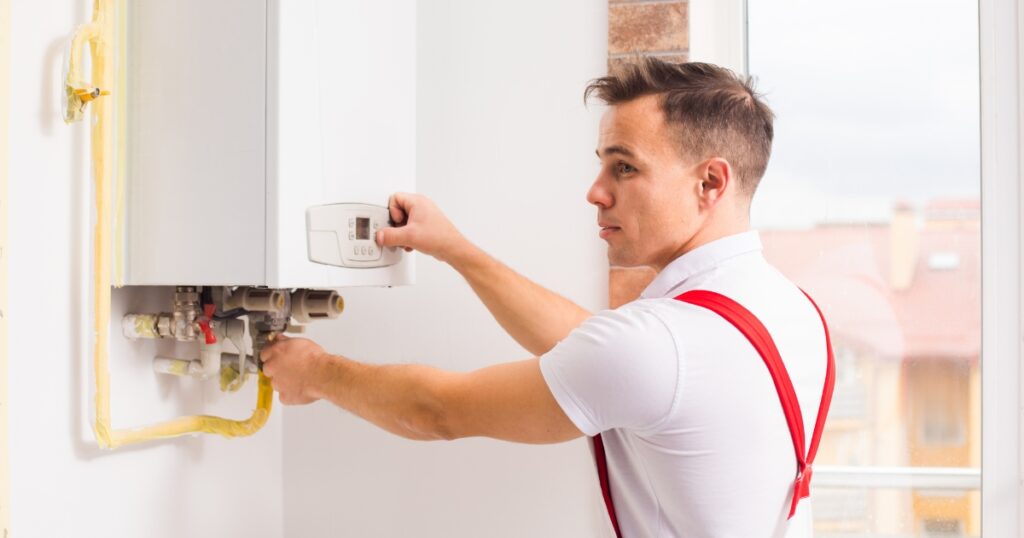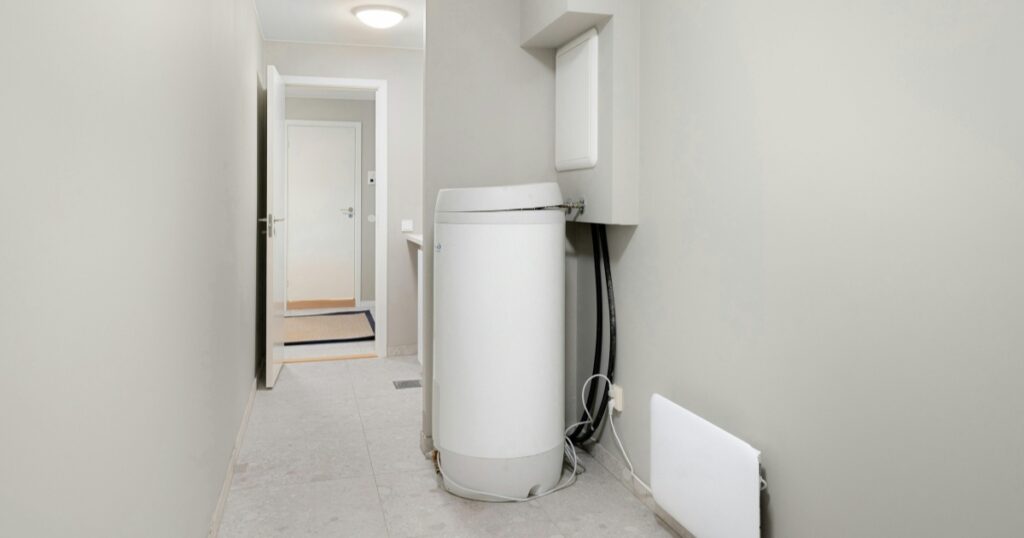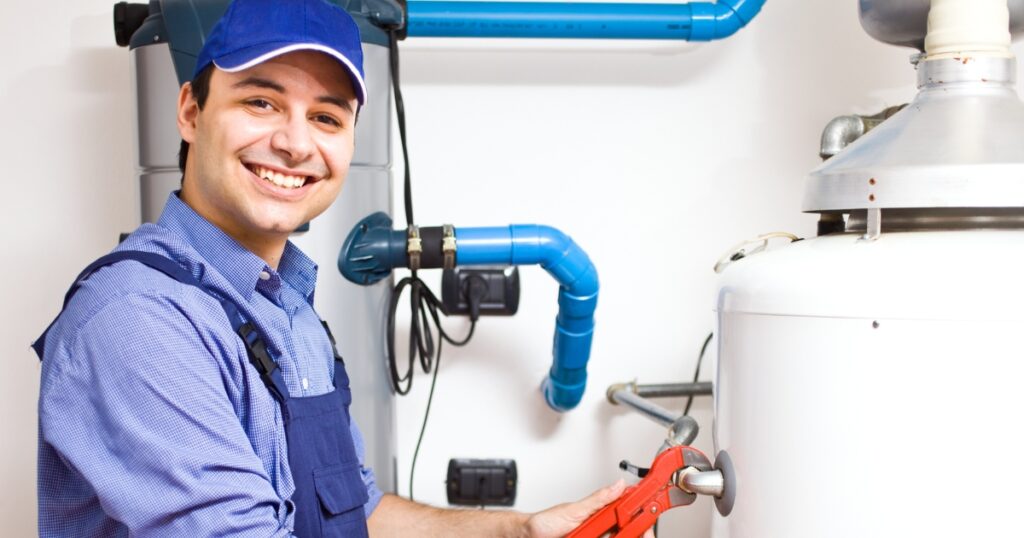Stumbling upon a leak in your hot water service line is one of those all-too-common headaches nobody’s keen on. We know the feeling all too well, having navigated through it ourselves.
After diving deep into research and a bit of good old trial and error, we’ve uncovered that such leaks may just be the tip of the iceberg signalling larger issues looming under the surface.
This guide is designed to help you pinpoint exactly where that pesky leak is coming from, tackle it with confidence, and make an informed decision on whether to patch things up or go for a full replacement.
Keep reading to sort out that leak today – you’ve got this!
Key Takeaways
- Hot water leaks can come from the top or bottom of the tank, faulty pressure relief valves, or loose pipes. Identifying where the leak is coming from helps fix it properly.
- Turning off your water supply and draining your hot water system are necessary steps before any repair work begins to prevent further damage.
- Calling a licensed plumber ensures that leaks in hot water service lines get fixed efficiently and safely. They have expertise in identifying problems and repairing them correctly.
- Regular maintenance checks help catch issues early on, avoiding more significant problems and ensuring your hot water system runs smoothly.
- Deciding whether to repair or replace a leaking hot water system depends on its age, location of the leak, severity, and cost comparison between fixing versus getting a new one.

Identifying the Source of the Leak
To identify the source of the leak, carefully check both the top and bottom of your hot water tank. Look for signs of water around the tank, loose pipes, or issues with pressure relief valves.
Top of the water tank (faulty anode rod, loose pipe, or leaking valve)
We often find that leaks at the top of the water tank signal issues like a faulty anode rod, a loose pipe, or a leaking valve. These components are crucial for your hot water system’s proper functioning and safety.
A corroded anode rod can’t protect the tank from rusting, while loose pipes or failing valves lead to unwanted water escape. Addressing these leaks promptly prevents more severe problems down the line.
Fixing leaks in hot water service lines starts with pinpointing their exact origins. If you notice dampness or pooled water near your tank’s top, it might be time to check these elements closely.
Replacing a worn-out anode rod or tightening connections might seem straightforward but demands accuracy and knowledge about your specific hot water system model. Calling in plumbing services ensures that not only is the leak fixed properly but also helps in avoiding potential hazards associated with incorrect repairs.
Bottom of the water tank (damaged drain valve or corroded tank)
Inspect the bottom of the water tank for a damaged drain valve or signs of corrosion on the tank itself. A corroded tank can result in leaks, while a faulty drain valve might cause water to escape.
Addressing these issues promptly is crucial to prevent further damage and potential flooding. Regular maintenance and inspection play a vital role in identifying these problems early, helping you avoid more extensive repairs down the line.
Upon noticing any leaks or signs of corrosion at the bottom of your hot water system, it’s best to seek professional help immediately. Ignoring these warning signs may lead to more significant problems and costly repairs in the future.
Pressure relief valve (faulty valve or excessive pressure)
The pressure relief valve is crucial for maintaining safe operating conditions in your hot water system. A faulty valve or excessive pressure can lead to leaks and potential safety hazards.
Regular inspection and maintenance of the pressure relief valve are essential to ensure it functions properly.
Excessive pressure within the hot water tank can cause the pressure relief valve to malfunction, leading to leaks and potential damage. It’s important to have a licensed technician inspect the valve regularly to ensure it operates correctly, relieving excess pressure and preventing leaks or other issues.
Turning Off the Water Supply
To turn off the water supply, locate the main shut-off valve near your hot water system. Rotate the valve clockwise until it is fully closed to stop the flow of water into your system.
This step is crucial in preventing further leakage and allows for safe troubleshooting or repair of your hot water service lines. Turning off the water supply also helps prevent potential damage to your property from a leaking hot water system, and it is an essential initial action when addressing any issues with your system.
Once you have turned off the water supply, be sure to drain excess pressure by opening a nearby faucet or releasing pressure through a relief valve if necessary. Drain any remaining water from the tank before proceeding with identifying and repairing leaks in your hot water service lines to ensure safety during maintenance.
Regularly turning off the water supply can assist in avoiding major problems and prolonging the lifespan of your hot water system.
Calling a Professional Plumber
To ensure that hot water leaks are addressed promptly and efficiently, it is crucial to engage the services of a licensed plumber. Their expertise and experience will help in accurately diagnosing the issue and carrying out necessary repairs.
For further details on troubleshooting and repairing hot water service line leaks, continue reading below.
Importance of addressing hot water leaks promptly
Address hot water leaks promptly to prevent further damage and potential safety hazards. Timely intervention can help avoid more extensive repairs or the need for a complete replacement of your hot water system.

Leaks may indicate underlying issues, which, if left unattended, could lead to increased energy costs and even property damage. Regular maintenance checks are crucial to identify any leaks and ensure the efficient running of your hot water system.
Detection and prompt repair of leaks are essential for preventing inconvenience caused by water loss or disruptions in the supply of hot water. Ignoring leaks can also result in higher utility bills due to the constant use of energy to heat up new supplies of cold water entering the tank.
Experience and expertise of a licensed plumber
A licensed plumber brings valuable experience and expertise to the table when addressing hot water system leaks. Their in-depth knowledge allows them to quickly identify the source of the leak, whether it’s a faulty anode rod, loose pipe, or damaged pressure relief valve.
With their professional training, they can efficiently troubleshoot and repair leaks by replacing faulty components and tightening connections. Additionally, licensed plumbers have the skills to determine if a leaking hot water system requires repairs or replacement based on its age and the severity of the leak.
Once you’ve called in a professional for your leaking hot water system, it’s important to understand troubleshooting and repairing leaks in more detail.
Troubleshooting and Repairing Leaks
First, identify the source of the leak. Then, turn off the water supply and call a professional plumber to troubleshoot and repair leaks in your hot water service lines. Ready to fix those annoying leaks? Let’s dive into it!
Replacing a faulty anode rod
If you have a leaking hot water system, one possible cause is a faulty anode rod. The anode rod’s role is to attract corrosion and protect the tank from rust, which can lead to leaks.
Replacing the faulty anode rod is crucial in preventing further damage and maintaining the integrity of your hot water system. Regular maintenance and inspection will help identify when this part needs replacement, ensuring that your system continues to operate efficiently.
When dealing with leaking hot water systems, it’s important to remember that addressing issues promptly can prevent more serious problems from occurring down the line. A small amount of water leakage from a hot water system can indicate the need for repairs or replacement by a licensed technician familiar with troubleshooting hot water service lines.
Tightening loose pipes
When addressing a leaking hot water system, tightening loose pipes is often a crucial step in the repair process. Over time, the connections between pipes and fittings can become loose, leading to leaks.
Identifying and securing any loose pipe connections can help prevent further water loss and potential damage to your hot water system. Regular maintenance checks should include inspecting all visible piping for signs of corrosion or looseness to ensure that the system operates efficiently.
If left unaddressed, loose pipes may cause more severe leaks or even structural damage if they are not tightened promptly. It’s important to remember that even small leaks from loose pipes should be dealt with as soon as possible to avoid bigger issues later on.
Repairing a damaged drain valve
To repair a damaged drain valve in your hot water system, start by turning off the water supply to the tank. Once the water is off, attach a garden hose to the drain valve and direct it into a bucket or towards a suitable drainage area.
Open the valve to release any remaining water from the tank. Next, use a spanner to loosen and remove the damaged drain valve. Replace it with a new one, making sure it is tightly sealed.
Finally, turn on the water supply and check for any leaks.
Replacing the pressure relief valve
If the pressure relief valve on your hot water system is faulty or releasing excess pressure, it’s crucial to replace it promptly. A licensed plumber can correctly assess the situation and install a new pressure relief valve to ensure the safe operation of the hot water system.
Over time, minerals and debris can cause the pressure relief valve to malfunction, leading to potential safety hazards. Regular inspections and maintenance by a professional can help identify issues with the pressure relief valve before they escalate.
It’s important for homeowners to be aware that a faulty pressure relief valve can result in dangerous levels of pressure within the hot water system, potentially causing leaks or even an explosion if left unaddressed.

When to Repair or Replace a Leaking Hot Water System
Consider the age, location, and severity of the leak when deciding between repairing or replacing a leaking hot water system. Compare the costs of repair and replacement to make an informed decision about your hot water service.
Age of the system
The age of your hot water system plays a significant role in determining whether to repair or replace it. As hot water systems age, they are more prone to corrosion and wear, which can lead to leaks.
Older systems may have deteriorated components that are difficult or costly to repair, making replacement a more viable option.
Considering the potential for increased inefficiency and higher energy costs with aging systems can also influence the decision-making process. Older units tend to be less energy-efficient compared to newer models, affecting both performance and utility bills over time.
Location and severity of the leak
Inspect the top, bottom, pressure relief valve, and overflow pipe of your hot water system to identify the source and severity of the leak. This will determine whether a repair or replacement is needed.
Addressing leaks promptly can prevent more significant issues from occurring. Regular maintenance can also help in identifying potential problems early on.
Leaking hot water systems may require professional repairs or replacement by a licensed technician. A small amount of water leakage from a hot water system can indicate the need for repairs or replacement.
Cost comparison between repair and replacement
Let’s dive into understanding the cost comparison between repairing and replacing a leaking hot water system. It’s crucial for us homeowners to weigh our options carefully, considering both the immediate financial impact and the long-term implications.
| Aspect | Repair | Replacement |
|---|---|---|
| Initial Cost | Generally lower, varying based on the leak’s severity and location. | Higher upfront costs can lead to savings in energy efficiency and performance. |
| Long-term Savings | May incur more costs over time if leaks reoccur or lead to bigger issues. | Modern systems offer better efficiency, potentially lowering energy bills significantly. |
| Lifespan | Extends the current system’s lifespan but does not match the longevity of a new system. | A new system provides a fresh lifespan, often with a warranty for added peace of mind. |
| Effectiveness | Restores functionality, but old systems may still underperform compared to newer models. | Ensures optimal performance and often comes with new features for enhanced convenience. |
| Environmental Impact | Less waste is produced initially, but older systems may be less environmentally friendly. | Newer models are designed with eco-friendliness in mind, reducing carbon footprint over time. |
Considering these factors helps us make an informed decision. It’s about balancing the need for a quick fix against the benefits of long-term efficiency and reliability. Each situation is unique, and the best choice depends on our specific circumstances, including the age of our hot water system and the nature of the leak.
Prevent Leaks in Hot Water Service Lines
Repairing leaks in hot water service lines is crucial for preventing further damage. Identifying the source of the leak and turning off the water supply are essential first steps. Calling a professional plumber to troubleshoot and repair the leaks can save time and money in the long run.
Knowing when to repair or replace a leaking hot water system, based on its age and severity of the leak, is important for maintaining an efficient home. Regular maintenance can help detect potential issues early on, preventing costly repairs or replacements down the line.






